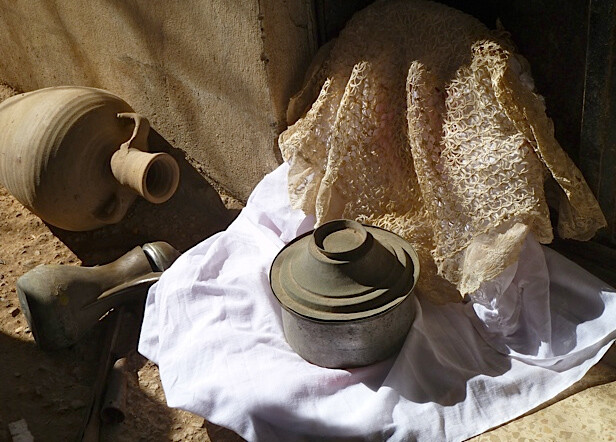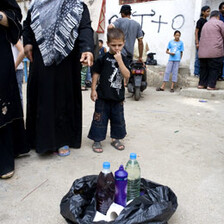The Electronic Intifada Beirut 26 July 2013

Shatila’s Memory Museum houses items donated by camp residents.
“We were living in Harboush [south Lebanon]. I was four years old. My mother had a bridal chest; only she had the key. Every woman had a chest like this. My uncle who had camels brought furniture from Palestine when he saw that we were going to stay. These things were beautiful. I liked them.”
This recollection of childhood as a refugee comes from a Palestinian doctor, Muhammad al-Khatib. Nearly sixty years later his childhood attraction to the objects of everyday life in Palestine bore fruit in a Memory Museum in Shatila, a refugee camp in Beirut.
Opened in 2004, the museum contains approximately 1,000 objects mainly donated by the camp’s residents. Overcrowded building has deprived the museum of light, and leaking water has dampened one wall. Viewing the museum by candlelight makes its objects fabulous.
An older camp museum is the one in Mashouq, in south Lebanon near Tyre. Its creator, Mahmoud Dakwar, said, “I was 11 years old in 1948. I collected books. And when I was expelled from my country I collected objects from Palestine. They were few. My dream was to light up the past before 1948.”
His reasons for setting up the museum? “To establish the civilization of Palestine. Palestine was not a country without a people. It was a country of milk and honey. How else are people going to remember?”
Books from floor to ceiling
So when he took his indemnity from the UN agency for Palestine refugees (UNRWA), he bought the large room where the museum and library are housed. The walls are stacked from floor to ceiling with books and manuscripts, mostly about Palestine. Another section contains at least 3,000 original pieces.
The Cultural Center in Beirut’s Mar Elias camp held its first exhibition in May this year with a set of memorabilia from the Palestinian city of Jaffa (Yaffa). Its creator, Imad Mokhtar, said, “The reason for making the cultural center and inaugurating it with the exhibition about Yaffa is that one of our friends from this camp, who was killed at Maroun al-Ras in 2011, was from Yaffa. The center is made in his name, and to commemorate the right of return [for Palestinian refugees].”
Maroun al-Ras was the scene of a mass Palestinian and Lebanese march to the Lebanon’s boundary line with Israel on Nakba Day (15 May) in 2011, during which the Israeli army killed 12 and wounded hundreds.
Though the Mar Elias center is not primarily a museum, it has approximately 80 objects. Mohktar intends to add more in the future. A striking item in his collection is a large bridal chest packed with embroidered clothes and shawls.
Coffee culture

Leaking water has dampened one of the Shatila Memory Museum’s walls.
Mokhtar emphasized that he is in frequent contact with his relatives in historic Palestine: “I still have a cousin and aunt who live in Haifa; I talk to them by phone. We had the best restaurant in Haifa, the Matam Umam. It had five floors. My mother told me how life was in Palestine. They had photos. Their home is still there.”
The objects the expelled brought with them tell many different stories. Most obviously they tell how everyday life was before the Nakba — Arabic for catastrophe used to describe the ethnic cleansing ahead of Israel’s establishment in 1948. They show what people wore, the tools they used, how they prepared food.
The cultural importance of coffee shows up in shelves full of carafes of different shapes, sizes and functions. A mesh-covered cupboard — or namliyya — in the Shatila museum reminds us how people preserved food before refrigerators.
The Mashouq museum has a set of cattle bells, each one with a different shape and sound, the smallest for the camel, the heaviest for goats. There’s a chain for a mare that couldn’t be opened except by its owner or with a shot gun.
The quantity of farming equipment here suggests that many of those expelled from Palestine continued to practice farming in south Lebanon. The Shatila and Mar Elias collections are more domestic.
Grabbed in chaos
The objects also show what people grabbed in the chaos of the uprooting, often surprisingly heavy items such as irons and urns for kibbeh, a traditional dish made from ground meat and bulghur wheat, or personal fragments such as photos, a model ship, a sock stretcher, a doll. What these objects meant to people, why they kept them in exile, and why at a certain moment they agreed to give them up to a public collection are questions we need to ask the original owners.
The stories the objects signify are part of Palestinian history.

Shatila’s Memory Museum includes surprisingly heavy items, such as irons.
These local camp museums bear similarities to village history books that were written following the Oslo accords in the mid-1990s. In Palestinian Village Histories: Geographies of the Displaced, Rochelle Davis attributes the growing interest in Palestinian history and culture to a feeling that the Palestinian Authority was abandoning the right of return.
The social and demographic background of the museum-makers is similar to that of the village history authors.
Dakwar, al-Khatib and Mokhtar come from the jeel al-Nakba (the generation of the catastrophe), growing up as children in close contact with parents and grandparents who lived in Palestine. All three succeeded in school and became professionals, Dakwar as an UNRWA teacher and headmaster; al-Khatib as a doctor with the Red Crescent and UNRWA; Mokhtar as a journalist with a prominent Lebanese newspaper.
They are part of a camp-based intelligentsia distinguished by concern for education, culture and memory.
Lustre
Like the village histories, museums in camps imply a certain critique of the national leadership, especially its neglect of Palestinian history and culture, and its divorce from the refugees. Disillusion with the PA’s policies has added lustre to objects that recall the lost country.
Another common characteristic of all three collectors is their concern for youth. Children in UNRWA schools in Lebanon are not taught Palestinian history — indeed history books for Palestinian children hardly exist anywhere.
Al-Khatib believes that Palestinian children are psychologically damaged by the absence of a national history. Before opening a museum, he used to hold weekly discussions for Shatila youth “because the factions only taught them how to clap,” he said.
“We live under severe oppression; we have no future in Lebanon,” he added. “So we must struggle to return to Palestine, not just by fighting, but by art and science.”
He plans to use the center to conduct training sessions for young Palestinians in the few professions Lebanese law allows them to practice, such as journalism and photography. Dakwar sees knowledge of Palestinian culture as essential to an eventual peace settlement: “We have a civilization; it needs to be known so Muslims, Jews and Christians can live together in peace, as under the [British] Mandate,” he said.
All three centers seem well set in their social environment. “Ordinary people were happy about the museum, nobody was against [it],” al-Khatib said, though he added that no local organization or faction has supported him.
Dakwar said, “All school classes have visited, and students from Sibleen [a training center for refugees] and universities. Mashouq is known internationally through the media. Visitors are amazed. They see that we’re not asleep.”
Mokhtar, meanwhile, is pleased with the response to his exhibition on Jaffa. “People came from outside the camp, from other areas, young as well as old. We see it as a way of evolving. We collected 80 objects, so why not make a permanent museum? And always hold a new exhibition, maybe six a year?”
What makes people give up precious mementos of Palestine to a public collection? It seems that at a certain moment people felt that when they die their children would throw out objects that are no longer functional — or sell them.
“They belong to Palestine”
Being respected as patriots who serve their communities must have helped these three men to build their collections. They deny ownership. Al-Khatib said, “When I die this will all go to the [PA] ministry of culture.”
Dakwar expressed a similar sentiment: “When there is a Palestinian capital in Jerusalem these things will go there. The museum is not in my name. All the pieces belong to Palestine.”
Despite the generous support the museums have received from Palestinian refugees, official support has been lacking. Dakwar said, “No one has helped me, neither with buying objects, nor with electricity, nor with cleaning. This museum needs to carry on but I can’t afford to train and employ someone to keep it open.”
Family members have helped him with cataloguing and research (he has published several books including a history of his village Qadeetha, near Safed in the Galilee region of historic Palestine), but no Palestinian institution has offered help.
The Shatila museum needs repairs and electricity. Al-Khatib has listed every object in his museum, as well as the stories people tell about them. But he admitted that he was getting tired. “I need people to help me. I need a computer, Internet, a secretary. I can’t pay people.”
“Archive fever”
It seems as if the fading away of the “generation of Palestine” has inspired exiled Palestinians to grasp whatever is left of connection with the homeland. As Beshara Doumani writes in the Winter 2009 issue of Jerusalem Quarterly, Palestinian “archive fever … is driven by a deep and widespread pessimism about the future,” as well as a perception that the current leadership is incapable of “salvaging the Palestinian past and preparing for the future.”
Local museums have a long tradition among Palestinians, going back to the collections of Jerusalem families and to folklorists like Dr. Tawfiq Kanaan. The need to preserve and make known this past is a feeling expressed today by any Palestinian on the street, outside or inside the West Bank and Gaza.
As Dakwar put it, “How else are people going to remember?”
It is a people’s call that makes it imperative to strengthen local camp museums and enable them to create a “virtual gallery” which Palestinian children can visit, wherever they are.
Images courtesy of Dr. May Haddad and May Abboud.
Rosemary Sayigh, an anthropologist and oral historian living in Beirut, is author of Palestinians: From Peasants to Revolutionaries and Too Many Enemies: The Palestinian Experience in Lebanon.




